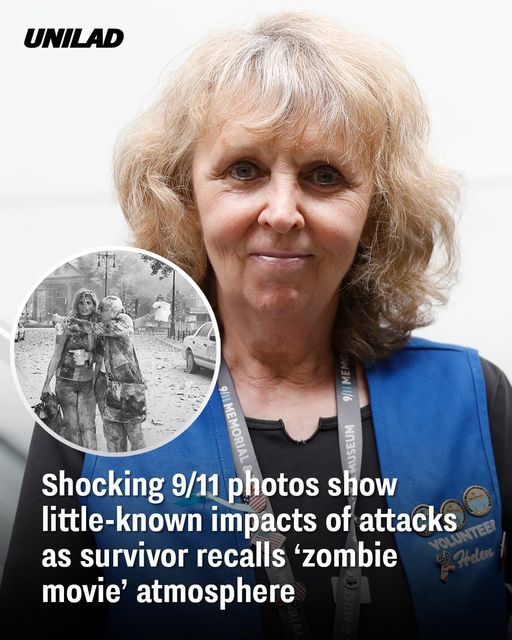“It was like in a movie. It was like a zombie movie or something… Nobody knew where to go or what to say, and it was very quiet.”
It was 23 years ago today when Inez Robertson found herself in the middle of one of the darkest days in US history, when four planes were hijacked and crashed in New York, Pennsylvania and Virginia.
Inez had been riding the subway when the first plane struck New York’s Twin Towers, and emerged to find thousands of people on the street, watching on as flames burst from the North Tower.

Inez works as a Visitor Services Volunteer at the 9/11 museum (Courtesy of the 9/11 Memorial & Museum)
‘It was a nightmare’
At first, Inez couldn’t understand what was happening.
“We were told it was a helicopter…I didn’t think it was a jet. But then I thought, well, a helicopter wouldn’t do all this damage,” she recalled.
With no idea about the severity of what was really going on, Inez continued to make her way to her job at an ad agency in Midtown.
“It wasn’t until I got up to the 19th floor where I worked… by then the second plane had gone in. And then we were told it was a terrorist thing.”
Inez was sent home, but with the entire city at a standstill she had to walk through the streets along with thousands of other New Yorkers.
“On the ground floor there was an electronic store that sold TVs, and all the TVs were on, and every TV had a different channel. All the channels, it was all showing you lower Manhattan,” she recalled.
“I was [walking] with somebody from my company, and we’re just like, in shock. It was like in a movie. It was like a zombie movie or something.”

The entire area was covered in ash from the towers (Courtesy of the 9/11 Memorial & Museum)
“It took me two hours to walk home, because by then the subway stopped, the busses, everything stopped,” Inez continued.
“It was a nightmare, but at least we were alive.”
It’s hard to comprehend the damage and destruction caused by the terrorist attacks, but eye-opening images shared by the 9/11 Memorial Museum help demonstrate the ways in which the city was affected.
One image captured a fire truck which had been parked nearby when the planes struck the Twin Towers. As the buildings collapsed, the vehicle was crushed, melted and deformed from the impact of the structure and the heat of the burning flames.

The firetruck was completely destroyed on impact (Courtesy of the 9/11 Memorial & Museum/Jin Lee)
Another image shows the extent of the damage to the buildings themselves, revealing a damaged steel beam from the North Tower which had been completely mangled when the plane crashed into it.

The structure of the North Tower was mangled and melted on impact (Courtesy of the 9/11 Memorial & Museum/Jin Lee)
‘It’s just hard to describe how bad it was’
While firefighters and volunteers worked at the scene of the towers, nearby residents swept ash from their homes, throwing away sheets, blankets and towels that had been covered as the buildings came down.
“I don’t think we had electricity or anything, for weeks,” Inez explained.
“Inside the apartment was covered in ash. I remember opening the door [after the attacks] and there were three men there, and they came in, and they basically cleaned our furniture, our couch, everything.
“I mean, it’s just hard to describe how bad it was.”
Desperate to help however she could, Inez began to volunteer at St Paul’s Chapel, where she served food to the firefighters working at the scene.
At the time, those surrounding the rescue and cleanup efforts weren’t aware of the effects of the toxic material they were being exposed to.

Firefighters worked to find survivors and clear rubble from the scene (Michael Rieger/Greg Mathieson/Mai/Getty Images)
Inez recalled: “I was serving food to the rescue workers and the firemen and the policemen, whoever came in. [We] didn’t realize that the dangers of the toxic [material], because they were coming in, and their uniforms were covered in dust and that kind of thing.”
In 2018, a report shared by Mount Sinai hospital stated that nearly 10,000 first responders and others who were near the World Trade Center in the wake of 9/11 have been diagnosed with cancer.
The report also stated that more than 2,000 deaths have been attributed to illnesses resulting from the 9/11 attacks.
To help educate and inform visitors about the attacks in New York, the near-3,000 people who died in them, and the work of the responders, Inez now works as a volunteer for the 9/11 Memorial Museum.
‘We should never forget.’
Needless to say, however, the physical impacts weren’t the only lasting consequences of 9/11.
For about six months after the attacks, Inez could ‘see the planes’ every time she closed her eyes to go to bed.
She continued: “When I’m working on the plaza, especially outside, and I see a plane… I look up even 23 years later, it still bothers me.”
But in spite of the heartache that can come with her job, Inez described working at the museum as a ‘calling’.
“I want to tell the story to future generations,” she explained. “We should never forget.”
